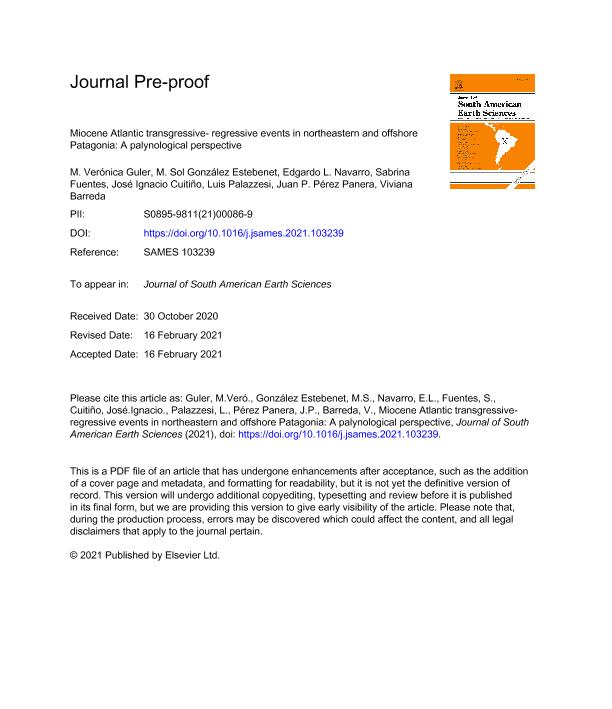Artículo
Miocene Atlantic transgressive - regressive events in northeastern and offshore Patagonia: A palynological perspective
Guler, Maria Veronica ; González Estebenet, María Sol
; González Estebenet, María Sol ; Navarro, Edgardo Luis; Fuentes, Sabrina Natalia
; Navarro, Edgardo Luis; Fuentes, Sabrina Natalia ; Cuitiño, José Ignacio
; Cuitiño, José Ignacio ; Palazzesi, Luis
; Palazzesi, Luis ; Pérez Panera, Juan P.; Barreda, Viviana Dora
; Pérez Panera, Juan P.; Barreda, Viviana Dora
 ; González Estebenet, María Sol
; González Estebenet, María Sol ; Navarro, Edgardo Luis; Fuentes, Sabrina Natalia
; Navarro, Edgardo Luis; Fuentes, Sabrina Natalia ; Cuitiño, José Ignacio
; Cuitiño, José Ignacio ; Palazzesi, Luis
; Palazzesi, Luis ; Pérez Panera, Juan P.; Barreda, Viviana Dora
; Pérez Panera, Juan P.; Barreda, Viviana Dora
Fecha de publicación:
08/2021
Editorial:
Pergamon-Elsevier Science Ltd
Revista:
Journal of South American Earth Sciences
ISSN:
0895-9811
Idioma:
Inglés
Tipo de recurso:
Artículo publicado
Clasificación temática:
Resumen
Key information for regional biostratigraphic, climatic and environmental reconstructions for the Miocene of the southwestern Atlantic margin can be obtained by qualitative and quantitative palynological analysis at the onshore YPF-CH-PV.es-1 borehole (PV borehole) in the Valdés Basin, combined with previously documented organic-walled dinoflagellate cyst data from the Colorado Basin and well-dated outcropping sections on the east coast of Patagonia. A sequence of eleven significant dinocyst bioevents (highest occurrence, HO; highest common occurrence, HCOs) is recognized across the Valdés and Colorado basins. The bioevents occur in the same stratigraphic order and seem to be synchronous across both basins. From the oldest to the youngest, these are: HO of Emmetrocysta urnaformis, HO of Cannosphaeropsis quattrocchiae, HCO and HO of Hystrichokolpoma rigaudiae, HO of Cousteaudinium auybriae, HCO and HO of Dapsilidinium pseudocolligerum, HO of Cleistosphaeridium ancyreum, HO of Labyrinthodinium truncatum, HO of Operculodinium piaseckii and HO of Reticulatosphaera actinocoronata. The presumed climatically-driven extinctions of Dapsilidinum pseudocolligerum and Hystrichokolpoma rigaudiae around the Burdigalian to earliest Langhian, may be linked to global cooling and the re-establishments of the Antarctic ice-sheets since ~14 Ma. Two maximum flooding episodes, characterized by warm, outer (distal) neritic environmental conditions were identified at the PV borehole, presumably related to glacio-eustatic sea level rise. The older occurred in the Burdigalian – earliest Langhian and the younger, in the Tortonian. The latter maximum flooding is followed by environmental and/or climatically-driven change, implying abrupt shifting from neritic to nearshore conditions, the extinction of the warm-water taxa, and dinocysts being largely replaced by acritarchs.
Palabras clave:
BIOSTRATIGRAPHY
,
MIOCENE
,
PALEOENVIRONMETS
,
PALYNOLOGY
,
PATAGONIA
Archivos asociados
Licencia
Identificadores
Colecciones
Articulos(CCT - BAHIA BLANCA)
Articulos de CTRO.CIENTIFICO TECNOL.CONICET - BAHIA BLANCA
Articulos de CTRO.CIENTIFICO TECNOL.CONICET - BAHIA BLANCA
Articulos(INGEOSUR)
Articulos de INST.GEOLOGICO DEL SUR
Articulos de INST.GEOLOGICO DEL SUR
Articulos(MACNBR)
Articulos de MUSEO ARG.DE CS.NAT "BERNARDINO RIVADAVIA"
Articulos de MUSEO ARG.DE CS.NAT "BERNARDINO RIVADAVIA"
Articulos(SEDE CENTRAL)
Articulos de SEDE CENTRAL
Articulos de SEDE CENTRAL
Citación
Guler, Maria Veronica; González Estebenet, María Sol; Navarro, Edgardo Luis; Fuentes, Sabrina Natalia; Cuitiño, José Ignacio; et al.; Miocene Atlantic transgressive - regressive events in northeastern and offshore Patagonia: A palynological perspective; Pergamon-Elsevier Science Ltd; Journal of South American Earth Sciences; 109; 8-2021; 1-14
Compartir
Altmétricas



